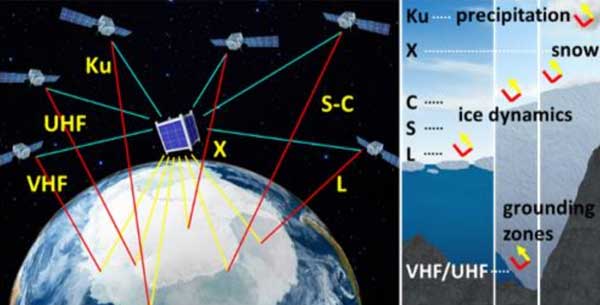
by Douglas Messier
Managing Editor
NASA is funding research into advanced satellite radar technology that would allow scientists to better measure Earth’s ice flows, ice shelves and snow accumulation.
The space agency awarded a NASA Advanced Innovative Concepts (NIAC) Phase I award worth $175,000 to Darmindra Arumugam of the Jet Propulsion Laboratory to develop a cryospheric Rydberg radar for use on Earth orbiting satellites.
“Rydberg Radar integrates state-of-art high sensitivity, low noise, ultra-broadband, quantum down-conversion – with no antenna/RF front-end/mixers. Configured as a signal-of-opportunity (SoOp) radar receiver, it has vast flexibility to sense dynamics/transients of multiple key cryospheric processes using spatially co-located multi-band navigation/communication signals,” the project abstract said.
The project abstract follows.
Cryospheric Rydberg Radar
Darmindra Arumugam
NASA Jet Propulsion Laboratory
NIAC Phase I
Amount: $175,000
Length: 9 months
Rydberg Radar builds on the disruptive and proven Quantum Rydberg atomic receiver technology to remotely sense key cryospheric science (CS) processes covering dynamics of ice flow, ice-shelf evolution, snow accumulation, and bedrock (including grounding line) mapping. Rydberg Radar integrates state-of-art high sensitivity, low noise, ultra-broadband, quantum down-conversion – with no antenna/RF front-end/mixers. Configured as a signal-of-opportunity (SoOp) radar receiver, it has vast flexibility to sense dynamics/transients of multiple key cryospheric processes using spatially co-located multi-band navigation/communication signals.
Rydberg Radar for CS operates on 6 distinct radar bands from VHF-to-Ku bands (covering 137MHz/255MHz/370MHz/1.2-2.2GHz/5.4-5.7GHz/7-9.6GHz/13.5GHz). Radio reflectometry techniques for SoOp are used to study/measure bedrock topography (137MHz), snow water equivalent (SWE) of snow accumulation (255 and 370MHz), ice sheet dynamics/flow (1.2-2.2GHz), snow accumulation rates (5.4-9.6GHz), and precipitation (13.5GHz). Downlink satellite radio signals with modulated data from multiple classes of science, communication, and navigation satellites are used.
The most significant advantages of the proposed technology are that it enables a (1) highly sensitive, (2) dynamically tunable ultra-broad-band radar system that dramatically improves over state-of-art classical radar using quantum Rydberg atomic sensing (10kHz to 1THz), and that (3) it does not require an antenna or RF componentry (detection volume is <1cm3 – fundamentally breaking the Chu limit for antennas in classical radars). The automatic quantum down-conversation due to electromagnetic induced transparency (EIT) brings the incoming radio signaling directly to baseband/IF (intermediate frequency) when the probe-laser signal is sampled by a photodetector.
Finally, the Rydberg Radar is ultimately limited by quantum projected noise limit (QPNL), which enables a more sensitive detector than the modern radar. The technology will enable a new class of quantum radar systems that are sensitive, tunable, and deployable-free. Although the focus is on CS transients/dynamics, the successful completion of the proposed study will enable various multi-frequency/-science missions in the future covering all aspects of radar remote sensing – with potential to generate great interest within NASA, the public, and industry covering virtually every application of radio/radar.

